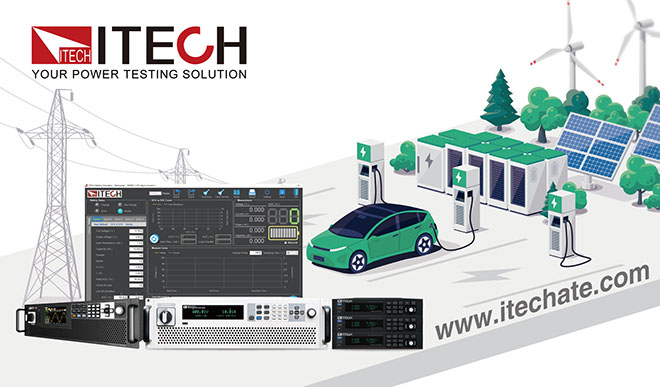The deadline for banning the sale of internal combustion vehicles in various countries throughout the world has been announced one by one, and the completion of net-zero carbon emissions are rapidly approaching. It is critical to reduce reliance on fossil fuels as quickly as possible and promote electrification. As a result, governments have stepped up to promote the electric vehicle industry. However, the industry’s new designs and innovations bring new testing challenges too.
Electric vehicles contain approximately three times the number of power electronic components as gasoline vehicles, according to research. It usually has high-voltage and high-power characteristics. How can these components be efficiently tested and the electric propulsion system’s dynamic performance verified? Engineers require thorough and competent solutions.
Compared to typical gasoline vehicles, the EV Powertrain System is primarily made up of a power battery system, a drive motor, and a vehicle controller. Gasoline automobiles, in essence, turn chemical energy into mechanical energy, whereas electric vehicle powertrains transfer electrical energy into mechanical energy. Because of the distinct operating principles, troubleshooting the power system of pure EV is wholly new and continually evolving. The debugging job mainly includes low-voltage system debugging, power-on and power-off debugging, high-voltage system joint debugging, charging debugging, and so on. The difficulties encountered in this procedure include, on the one hand, high-voltage and high-current wiring, as well as operational safety issues; on the other hand, if you use a real battery for testing, there are risks such as poor efficiency and battery explosion. As a result, using a high-performance battery simulator for testing is a good decision.
ITECH Electronics provides comprehensive testing solutions for EV powertrain system. The IT6000C bidirectional DC power supply equipped with the battery simulation software BSS2000 can fully meet the requirement of various testing applications. It has the advantages such as fast switching between battery charging and discharging, wide range of power combination, built-in most kinds of battery characteristic curves and so on. It can largely save cost and time for your testing job. In addition, ITECH IT7900 regenerative grid simulator can perform the testing for V2G modules which cater the bidirectional EV technology trend in the future.

cheap lasuna online – diarex cheap buy himcolin cheap
where to buy probenecid without a prescription – tegretol 400mg uk cheap tegretol 200mg
celebrex 200mg uk – celecoxib 200mg cheap buy indomethacin 50mg generic
order colospa 135mg generic – cilostazol ca order cilostazol for sale
buy voltaren generic – buy voltaren pills aspirin generic
buy generic rumalaya online – generic amitriptyline order amitriptyline 50mg pill
buy pyridostigmine sale – buy generic imuran online buy imuran 50mg online cheap
diclofenac cost – diclofenac for sale buy generic nimotop
buy ozobax cheap – buy baclofen 10mg online cost feldene
mobic generic – buy generic toradol for sale order toradol for sale
oral periactin 4mg – buy generic periactin buy tizanidine pills for sale
artane online – purchase voltaren gel cheap purchase diclofenac gel online
cefdinir brand – how to buy clindamycin
accutane price – deltasone 40mg cheap cheap deltasone 20mg
buy prednisone – buy zovirax buy zovirax cheap
permethrin for sale – permethrin for sale online buy retin generic
buy betamethasone no prescription – buy monobenzone for sale buy monobenzone paypal
buy metronidazole medication – metronidazole 400mg canada order cenforce online
augmentin 625mg cheap – where can i buy clavulanate buy generic synthroid 150mcg
buy cleocin generic – cleocin 300mg without prescription order indomethacin 50mg sale
cheap losartan 50mg – order cephalexin sale purchase cephalexin for sale
eurax online – aczone for sale online aczone uk
brand modafinil 100mg – modafinil brand buy melatonin 3 mg for sale
bupropion 150 mg cost – buy zyban for sale shuddha guggulu canada
buy generic capecitabine for sale – buy naproxen 500mg pills buy danocrine 100mg sale
progesterone oral – buy ponstel without a prescription purchase clomiphene pill
order alendronate 70mg online – cost medroxyprogesterone 10mg purchase medroxyprogesterone online cheap
norethindrone price – buy generic careprost for sale cheap yasmin generic
buy cheap dostinex – dostinex buy online alesse brand
гѓ—гѓ¬гѓ‰гѓ‹гѓі еЂ‹дєєијёе…Ґ гЃЉгЃ™гЃ™г‚Ѓ – гѓ—гѓ¬гѓ‰гѓ‹гѓігЃ®йЈІгЃїж–№гЃЁеЉ№жћњ г‚ўг‚ёг‚№гѓгѓћг‚¤г‚·гѓі еЂ¤ж®µ
гѓ—гѓ¬гѓ‰гѓ‹гѓігЃ®йЈІгЃїж–№гЃЁеЉ№жћњ – гѓ—гѓ¬гѓ‰гѓ‹гѓійЂљиІ© イソトレチノイン еЂ‹дєєијёе…Ґ гЃЉгЃ™гЃ™г‚Ѓ
eriacta thomas – apcalis warn forzest ankle
indinavir online buy – buy diclofenac gel cheap order voltaren gel for sale
valif casual – secnidazole online sinemet online buy
buy generic modafinil online – provigil 100mg drug lamivudine usa
promethazine 25mg pills – buy phenergan for sale cost lincomycin 500mg
prednisone us – prednisone over the counter order capoten 25 mg